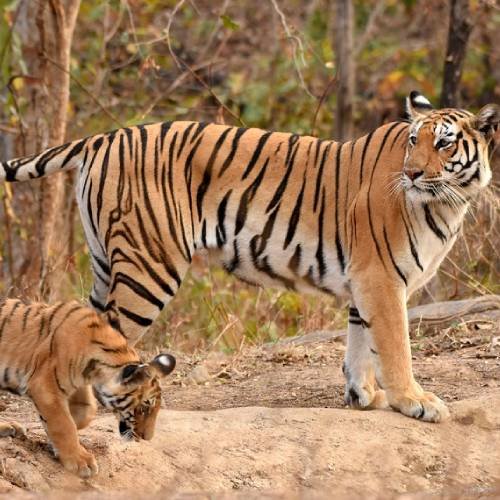Welcome to Jungal Safari Tour
Booking Form
Tour Package : All Inclusive
Sightseeing
Hotel Twin Sharing Basis
Food Veg & Non Veg
Transfers in Private Car
Air Tickets
Jungal Safari Tour
India is fortunate to be home to a diverse range of native plants and animals. It is the home of “TIGER,” one of the most magnificent creatures on the planet.The most depressing aspect is that we haven’t been able to appreciate and comprehend it.
This animal is in danger of going extinct due to human greed.The tiger, also known as the “Large Hearted Gentleman” after Jim Corbett, is struggling for its life in the wild. If this fight continues, there will only be a few hundred of these beasts left in the wild.Assist this magnificent creature in its final struggle for existence.
Why Us
Trusted Name in Kashmir Tour Packages
Best B2C Service Provider
Value for Money Packages
Customized Solutions
Personalized Services
Places To Visit



Tadoba
Maharashtra's oldest and largest National Park, the "Tadoba National Park", also known as the "Tadoba Andhari Tiger Reserve" is one of India's 47 project tiger reserves existing in India. It is about 150 km from Nagpur City and is located in the Chandrapur district of the state of Maharashtra. The Tadoba National Park, established in 1955, is included in the 1,727 square kilometre total area of the tiger reserve.


Kanha
Scattered over the districts of Mandla and Balaghat, the Maikal Hills of the Satpuras house Madhya Pradesh's largest national park, Kanha National Park. It is regarded as one of India's best-managed and administered wildlife national parks, spanning 940 square kilometres. It was notified as a wildlife sanctuary in 1933 after being designated as a reserve forest in 1879. Kanha was split into the 250 sq km and 300 sq km sanctuaries Hallon and Banjar in the 1930s.


Bandhav Gad
Bandhavgarh is located in Vindhya hills of Umaria district, Madhya Pradesh. In 1968 the area got its status of a National Park and now has become one of the preferred parks for Tiger Safari in India that includes photographing and tracking Tigers in wild.Famous for tiger sightings, the Bandhavgarh National Park is home to mammals, birds and butterflies. It also has tribal villages.


Pench
Pench National Park is a national park in India's Madhya Pradesh state, established in 1975 with an area of 257.26 km².It is famous for its ferocious Bengal Tigers that boasts a significant amount of tourism in the park. At present, there are around 50 tigers residing in the prey-rich woodlands of park's region. Besides this, the park also has 39 species of mammals 13 species of reptiles and 3 species of amphibians.


Ranthmbore
Ranthambore National Park is famous for its large tiger population. Ranthambore National Park is located in the state of Rajasthan. It is bounded to the north by the Banas River and to the south by the Chambal River. It was initially established as Sawai Madhopur Game Sanctuary in 1955.The Ranthambore Tiger Reserve is among the world's most prominent tiger reserves, serving as a sanctuary for the majestic Bengal Tiger species.


Gir
Gir Forest National Park is a wildlife sanctuary in Gujarat, western India. It was established to protect Asiatic lions, who frequent the fenced-off Devalia Safari Park, along with leopards and antelopes. Gir Jungle Trail, outside the fenced area, traverses deciduous forest and is home to wildlife including vultures and pythons.The Kamleshwar Dam has marsh crocodiles and birds, such as Indian skimmers and pelicans.



Kaziranga National Park
Kaziranga National Park is a protected area in the northeast Indian state of Assam. Spread across the floodplains of the Brahmaputra River, its forests, wetlands and grasslands are home to tigers, elephants and the world’s largest population of Indian one-horned rhinoceroses. Ganges River dolphins swim in the park’s waters. It’s visited by many rare migratory birds, and gray pelicans roost near Kaziranga village.


Jim Corbett
Jim Corbett National Park is a forested wildlife sanctuary in northern India’s Uttarakhand State. Rich in flora and fauna, it’s known for its Bengal tigers. Animals, including tigers, leopards and wild elephants, roam the Dhikala zone. On the banks of the Ramganga Reservoir, the Sonanadi zone is home to elephants and leopards, along with hundreds of species of birds.
Jungal Safari Tour Packages


Jungal Safari
Tour Package
Duration: 3 Nights /4 Days
FLIGHT
Meal
Hotels
Transfer




Flite




Hotels




Meal




Transfer



Tadoba
Tour Package
Duration: 4 Nights / 5 Days
FLIGHT
Meal
Hotels
Transfer




Flite




Hotels




Meal




Transfer



Kaziranga National Park Tour Package
Duration: 5 Nights / 6 Days
FLIGHT
Meal
Hotels
Transfer




Flite




Hotels




Meal












